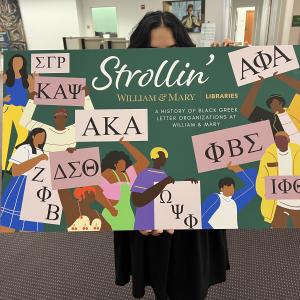Alexandra Flores, Instruction & Research Librarian and librarian to Anthropology, spoke to Assistant Professor, Dr. Andrea Wright, about her recently published book, “Between dreams and ghosts : Indian migration and Middle Eastern oil.”
Archive
Archive
- Scholarly publications (any publications for that matter from blogs to books) must adhere to some form of legal ownership structure. For us in the USA we follow the US Copyright Law (Title 17, 1-8, 10-12). Copyright was established in the US Constitution to support the progress of arts and sciences. Whenever you see the “c” copyright symbol and often when you don’t it means ALL rights reserved.
- Dr. Maurits van der Veen, (Associate Professor, Government) and Dr. Erik Bleich (Middlebury College) recently published Covering Muslims: American Newspapers in Comparative Perspective.
- Liz Bellamy, Instruction & Research Librarian and librarian to English, spoke to Adam Potkay, William R. Kenan, Jr. Professor of Humanities, about his recently published book, Hope: A Literary History.
- Open Education Week (OEW) is usually held the first full week of March, but it’s not the only time we could/should talk about open education. OEW is an international celebration with ideas and collaborations from around the globe, but what exactly is it that OEW celebrates? Why Open Education, of course! Okay, but what does open education mean?
- Candice Benjes-Small, head of research and librarian to Kinesiology and Health Sciences, spoke to Assistant Professor Carrie Dolan about her recently published article, “Cost-effectiveness of paediatric surgery: An evaluation of World Paediatric Project surgical interventions in St. Vincent and the Grenadines.”
- Altogether, William & Mary’s Richard Wright Collection of Graphic Images of African Americans holds more than 1,500 comics.
- Your work has been accepted for publication! Congratulations!
- Candice Benjes-Small, head of research and librarian to Kinesiology and Health Sciences, spoke to Assistant Professor Iyabo Obasanjo about her recently published article, “A Case Study of a Community Health Worker Program Located in Low-Income Housing in Richmond Virginia.”
- Instruction & Research Librarian Camille Andrews spoke to Dr. Joel S. Levine about his published book, "The Impact of Lunar Dust on Human Exploration."
- Strollin’, a new exhibit on view in the Marshall Gallery (1st floor rotunda in Swem Library), brings together belongings from members of Black Greek-letter organizations (BLGOs) at William & Mary.
- Announcement, annoucement, annooooouuuucement! Or Extra Extra Hear All About It! (depending on your persuasion and generational tendency). W&M Libraries is incredibly pleased to share that we have set aside funds ($100K in funds to be precise) to support faculty, students, and staff who want to publish their work open access!
- Textbook costs continue to rise, and you can be a part of the solution by incorporating low-cost and no-cost materials into your courses with Open Educational Resources (OER).
- I was late, to begin with. I hadn’t written about my time at the Swem Library’s Special Collections Research Center, within The Chapin-Horowitz Dog Book Collection. I kept promising myself—and others—that I would do it. The work was imminent. Forthcoming, shortly. About to arrive.
- Each year on the third Monday of January, the nation observes the legacy of Martin Luther King Jr. As a leader in the civil rights movement, King stood as a pillar of hope and a model of grace. His influence was pivotal in ending segregation and the national holiday provides an opportunity to reflect on the work that still needs to be done for racial equality.
- Candice Benjes-Small, head of research and librarian to Gender, Sexuality, and Women’s Studies, spoke to Dr. Jennifer Putzi about her recently published book, Fair Copy: Relational Poetics and Antebellum American Women's Poetry.
- The poem “A Visit from St. Nicholas” was first published in 1823 and attributed to Clement Clarke Moore as author in 1837.
- Open access has changed the way research is collected and disseminated. With so many scholars posting and publishing their work, it can be difficult for the algorithms (and interested human beings) to keep track of what work is yours. This is especially tricky when multiple scholars have the same name (Harry Potter or John Smith aren’t the only people experiencing attribution issues).
- In this post, we introduce W&M Libraries' new acquisitions assistant, Veronica Parker! Name: Veronica Parker Title: Collections Specialist
- By Rosie Liljenquist, Publishing and Open Access Librarian





















